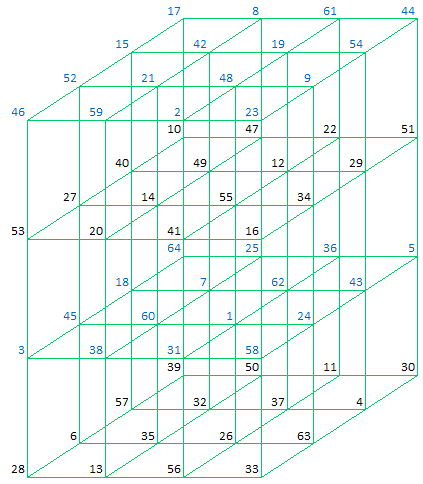|
The 8 Almost Perfect Magic Cubes which can be found for Pan Magic Square B1 and each of the possible Sudoku Comparable Cubes are shown in Attachment 3.5.2.
If the corresponding Classes are compared, it appears - as expected - that only four Classes contain different cubes.
Consequently of the Sudoku Comparable Cubes shown in Attachment 3.5.1 only the ones which can't be obtained by means of rotation or reflection of each other can be used (highlighted in blue).
An optimized guessing routine (MgcCube4b), produced the 384 possible Almost Perfect Magic Cubes for the Sudoku Comparable Cube shown above in 66 seconds, which are shown in Attachment 3.5.3 and further referred to as Collection {B}.
However not all elements of Collection {B} will result in a unique Class as defined in Section 3.1.
If the first cube of collection {B} is used as a Base Cube, the resulting Class (ref. Attachment 3.5.4) will contain
7 other elements of {B} (highlighted in red), due to the method the cubes of {B} have been constructed.
These 7 cubes should be excluded from the collection of possible Base Cubes. Continuing like this, a collection of 48
(= 384/8) possible Base Cubes will remain (ref. Attachment 3.5.5).
Consequently, based on the method described above, 48 * 48 = 2304 Almost Perfect Magic Cubes can be constructed for each of the 4 Sudoku Comparable Cubes.
It should be noted that, although quite fast, only a small portion of all possible Almost Perfect Magic Cubes can be constructed with this method.
3.5 Interactve Solution
The construction method described in Section 3.4 above has been applied in following Interactive Solution:
 |
 |
|
|
B1
|
C1
|
A1
|
|
|
|
|
|
B2
|
C2
|
A2
|
|
|
|
|
|
B3
|
C3
|
A3
|
|
|
|
|
|
B4
|
C4
|
A4
|
|
|
|
|
|
 |
 |
Procedure:
-
Select 4 Binaries out of the pairs
H1a/H1b,
H2a/H2b,
V1a/V1b and
V2a/V2b
with the 4 upper left selection buttons.
-
Select a sequence (1, 2 ... 24) for the four selected Binaries with the selection button left of the button ‘Sqr B1’
and confirm by pushing button 'SqrB1'
(for details regarding solutions based on Binary Matrices refer to Form4b).
-
Select one of the Sudoku Comparable Cubes with the lower left selection button, and confirm by pushing button 'SqrC1'.
-
Press the button ‘Calculate’ to calculate and visualise the resulting Magic Cube A of the 4th order.
Press the button ‘Show 3d’ to visualise the constructed cube in 3d view.
Have Fun!
|





